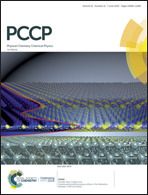In situ reversible redox switching of first hyperpolarizability of bimetallic ruthenium complexes†
Abstract
In this article we report the reversible redox switching of first hyperpolarizability of bimetallic ruthenium complexes bridged by bipyridyl tetrazine (bptz) ligands by second harmonic light scattering experiments (SHLS). We have synthesised [RuII(acac)2(CH3CN)2] and [(acac)2Ru-bptz-Ru(acac)2] complexes and measured their first hyperpolarizabilities as a function of in situ electrochemical oxidation/reduction of the metal centres. As a result of the oxidation of ruthenium centre from Ru(II) to Ru(III), the molecular hyperpolarizability of the complexes went up. The mixed-valence intermediate bimetallic complex and not the fully oxidized complex exhibit the highest β value of 780 × 10−30 esu. We also demonstrated that the hyperpolarizability is reversible with the change of the oxidation state of the metal and both the complexes are stable for several cycles of redox switching. The experimental results are also supported by calculations.



 Please wait while we load your content...
Please wait while we load your content...